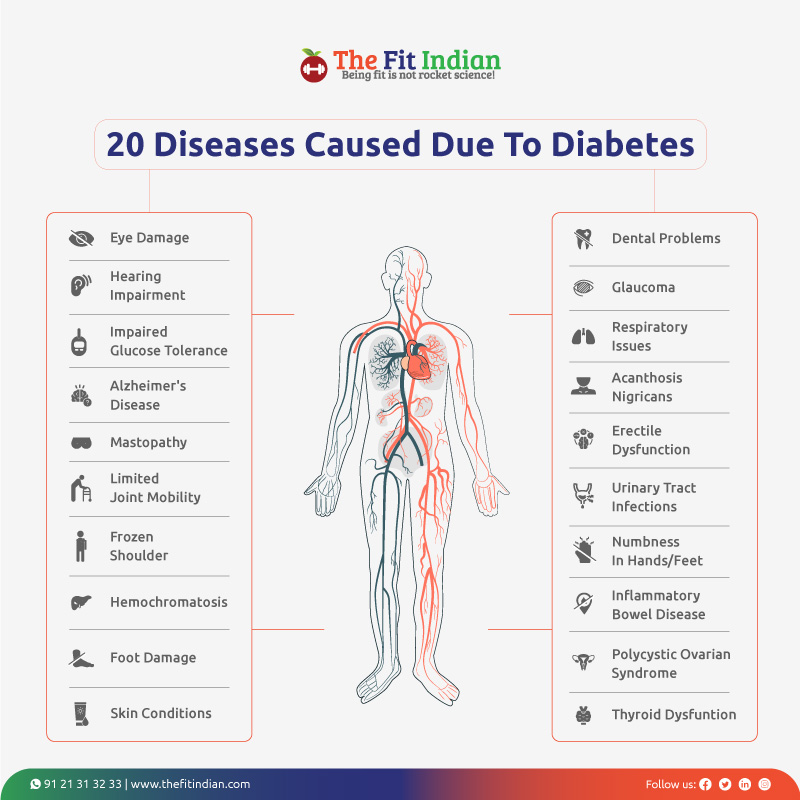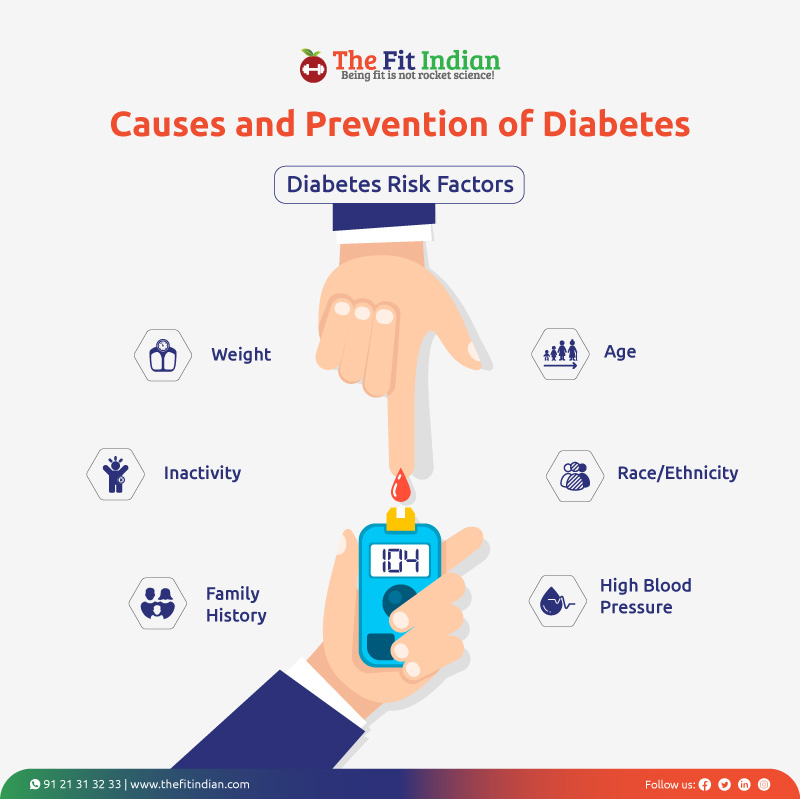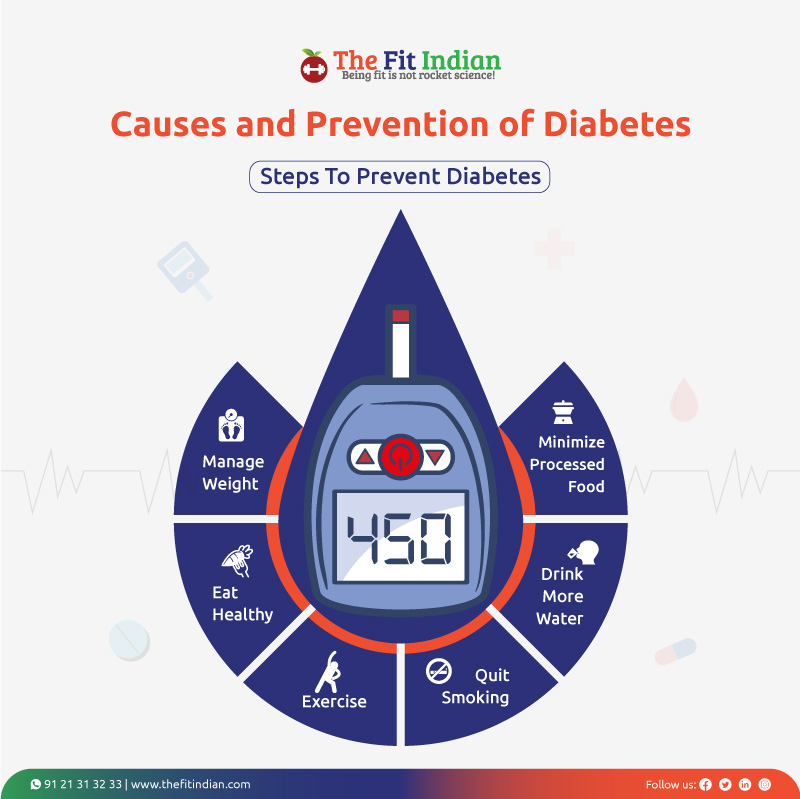How Diabetes Causes Eye Damage, Respiratory Issues and 20 Other Problems
Reviewed by: Dr. T S Deepthi Sarojini | Author: Manoja Kalakanti
Diabetes is a chronic disease that impairs the body’s ability to regulate or use sugar (glucose), which acts as a fuel to provide energy. In such an instance, either the pancreas is unable to produce enough insulin, or the body fails to use this insulin effectively. This hampers the ability of glucose to reach the cells; hence it stays in the blood. The amount of glucose slowly builds up in the blood, causing high blood sugar. Over time this could lead to health complications, some low risk while others more severe in nature. In this article, we’ll talk about the 20 low-risk diseases caused due to diabetes.

There are myriad risk factors or causes of type 2 diabetes. It is critical to understand them in order to prevent or manage the condition. First, let’s look at the 20 most common low-risk diseases that are caused by diabetes. This article will also highlight the factors responsible for the condition and the necessary preventive measures.
20 Low-Risk Diseases Caused by Diabetes
It is vital to visit your doctor at the earliest if you observe any of the typical symptoms associated with diabetes. The earlier you start managing the condition, the higher the chances of averting any health consequences that may eventually develop. Some of the diabetes symptoms are:
- Frequent urination
- Insatiable hunger
- Excess thirst
- Unexplained weight loss
- Frequent infections
- Blurred vision
- Fatigue
- Irritability
- Slow-healing sores
These are common symptoms associated with other conditions. Watch out for these symptoms and visit a doctor if you suspect it could be related to diabetes. Just be aware that it can be tricky to discern the difference between diabetes and any other conditions through these symptoms alone.

Here is the list of 20 low-risk diseases caused due to diabetes:
1. Eye Damage
Many eye-related problems can be caused due to diabetes. Glaucoma, cataracts, and diabetic retinopathy are some of these conditions. But can diabetes cause blindness? Yes, diabetic retinopathy could lead to blindness.
2. Foot Damage
The damage caused to the nerves and the blood vessels due to diabetes causes damage to the hands, legs and feet. People with diabetes are also more prone to be afflicted with common conditions such as calluses, fungal infections, and bunions.
3. Hearing Impairment
Studies show that the chances of a person with diabetes suffering from hearing loss are twice as much compared to non-diabetic people. This phenomenon could be attributed to the damage caused to the nerves and the blood vessels because of diabetes.
4. Alzheimer’s Disease
According to experts, there is no concrete evidence to back the theory that diabetes may cause Alzheimer’s disease or other dementias, yet the probability is high. Diabetes may increase the risk of developing mild cognitive impairment (MCI). MCI is a condition in which cognitive (thinking) and memory problems are more severe than normal ageing. Experts believe a healthy diet, exercise and blood sugar management may help avoid this.
5. Mastopathy
Diabetic mastopathy (DMP) is a condition that occurs when hard, fibrous masses develop in one or both breasts. These non-cancerous masses have also been observed in men. High blood glucose is considered to be the cause of this condition.
6. Limited Joint Mobility
Diabetes patients may suffer from limited mobility in the joints. This is usually observed in the joints of the hands. It could manifest in other joints as well. This condition can affect the quality of life as it impairs the ability to perform daily activities.
7. Frozen Shoulder
This is a condition that occurs when the ligaments around the shoulder joints become swollen and stiff. This pain and discomfort can last for a long time and affect day-to-day activities. Although it can happen to anyone, people with diabetes are at a significantly higher risk.
8. Hemochromatosis
Hemochromatosis is a condition that is closely linked to diabetes. It is a condition in which there is an excess amount of iron in the blood. This is secondary diabetes (a type of diabetes that occurs due to other conditions). Hemochromatosis is inherited, and its symptoms are fatigue and unexplained weight loss. Over time, this condition damages the pancreas, thus eventually leading to diabetes.
9. Impaired Glucose Tolerance
This is a condition where the blood glucose is more than the normal level but not enough to be diagnosed as diabetes. Impaired glucose tolerance could result in diabetes and cardiovascular disease. Eating a healthy diet, managing your weight and engaging in physical activity can prevent this condition.
10. Skin Conditions
Among the body parts that are affected by diabetes is the skin. Many signs manifest on the skin due to high blood sugar levels. Many skin problems can be observed, such as:
* Skin infections
* Open sores and wounds
* Granuloma annulare
* Dry, itchy skin
* Skin tags
* necrobiosis lipoidica
* Acanthosis Nigricans
11. Dental Problems
Due to reduced blood supply due to diabetes, there could be oral health problems such as bleeding, swollen gums, gum infections and cavities. Gingivitis, periodontitis, and bad breath are also common occurrences.
12. Inflammatory Bowel Disease
Both diabetes and Inflammatory Bowel Disease (IBD) are closely linked. Both the conditions are associated with inflammation and impaired immune function.
13. Numbness In Hands/Feet
This could be a result of a condition called Diabetic Neuropathy. If not controlled, diabetes can result in diabetic neuropathy, in which the nerves that send signals from your hand to feet are damaged. This can cause numbness and a tingling sensation in your fingers, hands, and feet. You may also experience a burning sensation.
14. Acanthosis Nigricans
Acanthosis Nigricans is a skin condition that is perceived as a warning sign of prediabetes. In this condition, you can observe dark patches on your armpit, back of your neck and other parts of the body.
15. Erectile Dysfunction
Erectile Dysfunction is a common problem in men with type 2 diabetes. Not managing blood sugar levels for a long period of time causes damage to the nerves and blood vessels, which may cause erectile dysfunction.
16. Respiratory Issues
The lung functions could be impacted due to an increase in blood glucose levels. Experts suggest that inflammation is the primary cause of the worsening lung function in people with diabetes. Studies show diabetes patients to be at a higher risk of suffering from asthma, pulmonary fibrosis and more likely to experience severe pneumonia.
17. Glaucoma
Glaucoma is a condition that damages the optic nerve in the eye. Glaucoma is caused due to extreme pressure inside the eyes, and diabetes can increase the risk of glaucoma. This could even lead to blindness.
18. Urinary Tract Infections
Since diabetes affects the nerves and the blood flow, it can worsen urological conditions. Diabetes can even cause urinary tract infections and bladder issues. People with the condition are at a higher risk of developing a UTI.
19. Polycystic Ovarian Syndrome
Since PCOS is linked to a higher level of circulating insulin, it is related to diabetes.
Women with a family history of diabetes are at higher risk of developing PCOS.
20. Thyroid
It is quite common for people to suffer from both diabetes and thyroid conditions at the same time. Diabetes increases the risk of developing thyroid disease, while thyroid disease also increases the
risk of type 2 diabetes. Diabetes can cause a change in thyroid hormone levels.
It is imperative to have a deeper understanding of the risk factors of diabetes in order to prevent the condition, thereby preventing the low-risk diseases caused due to diabetes. Let’s look at the most common risk factors and the measures needed to prevent diabetes.
Risk Factors and Prevention of Diabetes
The jury is still out on the precise reason why some develop prediabetes and type 2 diabetes, and others don’t.

But certain risk factors have been universally recognised as common causes of diabetes.
Risk Factors of Diabetes
Below are some of the most common factors that result in diabetes:
1. Weight
This is often considered to be among the primary risk factors that cause diabetes. A vast majority of people with the condition are overweight or obese. Obesity increases fatty acids and inflammation, which leads to insulin resistance, thus ultimately leading to diabetes.
2. Inactivity
Physical inactivity can result in insulin resistance. Inactivity is also directly related to obesity. The more inactive you are, the more weight you gain, the more weight you gain, the higher the risk of obesity you have, eventually leading to diabetes.
3. Family History
This is one of the causes of diabetes mellitus that is beyond an individual’s control. You are more likely to get diabetes if you have a family history of the condition. But even with the odds stacked against you, you can still prevent diabetes by managing your weight and leading a healthy lifestyle.
4. Age
Older adults are at a high risk of getting diabetes. As you grow older, insulin resistance declines, thus increasing the risk of diabetes. The risk of developing severe complications due to the condition is also significantly higher amongst the more ageing population.
5. Race/Ethnicity
There is ample evidence that suggests a higher prevalence of diabetes in certain races or ethnicities. The condition is more common among Asians and Africans than Caucasians.
6. High blood pressure
Studies have shown that people with high blood pressure or hypertension are more likely to develop type 2 diabetes. Hypertension results in an increase in inflammation levels, which is the driving factor resulting in diabetes.
The above factors have probably cleared your doubts about what can cause diabetes. It can even occur during pregnancy (gestational diabetes) or affect women with PCOS (Polycystic Ovary Syndrome).
While these are some of the most common risk factors that cause diabetes, even a healthy person with the ideal weight could get diabetes. This can happen due to insulin resistance that may occur with no rhyme or reason, although the chances of such an occurrence are rare. But there is one way to reduce the risks considerably – through prevention!
Prevention Measures for Diabetes
No matter how many times it is reiterated, the good old adage “Prevention is better than cure” is the motto we must all adhere to. Diabetes complications can be averted through preventive measures.

Though other factors like genetics are out of our control, prevention is still your best option to keep the condition at bay.
1. Manage Weight
Not all those who have diabetes are overweight or obese, but a vast majority are. Obese people tend to carry visceral fat around organs such as the liver. This fat results in inflammation and insulin resistance, thus increasing the chance of diabetes. Studies have shown that even losing a small amount of weight can significantly lower the chances of developing diabetes among those with pre-diabetes. So, maintain a healthy diet and exercise regularly to ward off the chronic condition.
2. Eat Healthily
Eating healthy has multiple benefits, including preventing diabetes. Healthy eating can help you maintain a healthy weight, which is crucial in preventing the condition. Consume many fibre-rich foods – fibre helps in weight management and keeps blood sugar and insulin levels low. You must also cut down sugar and refined carbs while minimising the overall consumption of carbohydrates.
3. Exercise
There are several benefits of being physically active. Lack of physical activity is one of the primary causes of diabetes. Exercising helps you lose weight and keep your blood sugar levels low. Exercise also increases the insulin sensitivity of your cells; hence less insulin is required to keep blood sugar under control. Engage in aerobic exercises and strength/resistance training such as walking, swimming, running, weight training or yoga.
4. Quit Smoking
Smoking is one of the unhealthiest habits and is bad in more than one way. It can cause heart problems, cancer and even diabetes. Research has shown that people who smoke regularly are at a higher risk of getting diabetes than non-smokers. So, kick the butt before you kick the bucket!
5. Drink More Water
Water is a must for healthy living and survival itself. Studies have shown that high consumption of water can control blood sugar and result in better insulin response. When thirsty, many people are tempted to drink sweetened beverages and sodas that are harmful. Consuming high amounts of water can lower your thirst and thus stop you from drinking unhealthy beverages.
6. Minimise Processed Food
Processed foods are responsible for many modern-day health problems such as diabetes, heart diseases, hypertension and obesity. Processed or packaged foods contain oils, refined grains and additives that are harmful to our health and provide little nutritional benefits. By replacing whole foods with these processed foods, you will deny your body the benefits that whole foods offer in preventing diabetes.
The diabetes treatment also includes medications that can help keep the condition under control and ward off any major risks. However, there is a downside to the medicines, which is a tendency of developing side effects. So, apart from preventing it, the best bet is to manage the condition through the above natural methods. These methods can not only prevent or manage diabetes, but are also devoid of any side effects.
An Indian Diet Plan for Diabetic Patients
Your diet is key to the successful management of diabetes. A healthy diet can help you prevent the high and low-risk diseases caused due to diabetes. We have prepared a comprehensive Indian diet plan to keep your sugar levels in check.
Follow this diet plan to manage the condition and boost your overall health.

Click Here For Full Screen Image
For a customized diet plan, consult a dietician or a nutritionist.
Bottomline
Diabetes itself is not as dangerous as the risks associated with it. There are plenty of low and high-risk health problems that are a direct result of diabetes. While some of these conditions can cause minor problems, others could be deadly. Thus, the management of the condition is imperative. Even better is preventing it. Understand the causes of the condition and the ways on how to prevent diabetes, to avoid the low-risk diseases caused due to diabetes.
FAQ’s
1. What other diseases are caused by diabetes?
In the long run, there can be severe health consequences due to diabetes. Below are some of the diseases that can be caused because of diabetes:
- Eye Damage
- Foot Damage
- Hearing Impairment
- Alzheimer’s Disease
- Mastopathy
- Limited Joint Mobility
- Frozen Shoulder
- Hemochromatosis
- Impaired Glucose Tolerance
- Skin Conditions
2. What are at least 2 diseases that are common with diabetes?
Hypertension and heart disease are two of the most common conditions that are associated with diabetes.
3. What are 4 risk factors for diabetes?
Many reasons could lead to diabetes. So, what is diabetes caused by? Here are the 4 most common risk factors:
- Weight
- Sedentary lifestyle
- Genetics and family history
- High blood pressure
4. What can type 2 diabetes be mistaken for?
The symptoms of Latent autoimmune diabetes in adults (LADA) type 2 diabetes can be similar, hence resulting in mistaken diagnosis.
5. What are 3 symptoms of undiagnosed diabetes?
Frequent urination, extreme hunger and increased thirst are the 3 common symptoms of undiagnosed diabetes.
6. What is the real cause of diabetes?
Many factors lead to diabetes. But obesity and an inactive lifestyle are among the top reasons. Other factors may include age, genetics, ethnicity, and hypertension.
7. Can healthy people get diabetes?
It is a popular misconception that only overweight or unhealthy people get diabetes. Even people who lead a healthy life and have their weight under control can be afflicted with the condition due to insulin resistance. However, that doesn’t imply that leading a healthy life is not advantageous to prevent diabetes. A healthy diet and lifestyle can considerably reduce the risk of getting the condition.
8. What fruits should you avoid for diabetes?
Fruits are rich in nutrients and should be included in the diet. However, certain fruits have a high sugar content, which could spike blood sugar levels. Try limiting or avoiding these fruits:
- Overly ripe bananas
- Watermelon
- Pineapple
- Mango
- Sapodilla
- Custard apple
- Jack fruits
- Grapes
9. Is diabetes a disability?
Laws may differ from one nation to another. Type 1 diabetes is considered to be a disability in the US, while it is not so in India.
10. Can diabetes go away?
There is no cure for diabetes, but a patient with the condition can live a healthy life with proper management.




Manoja Kalakanti